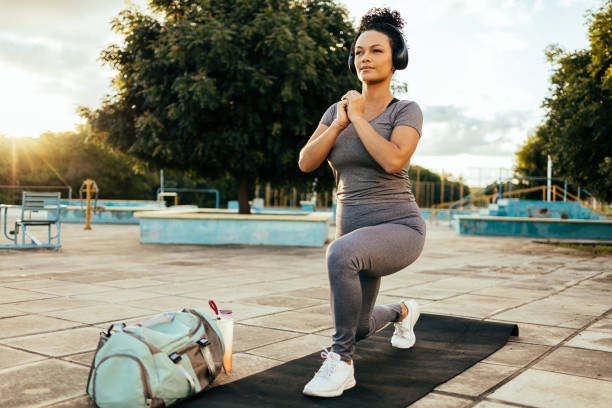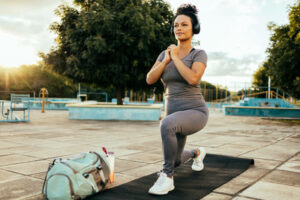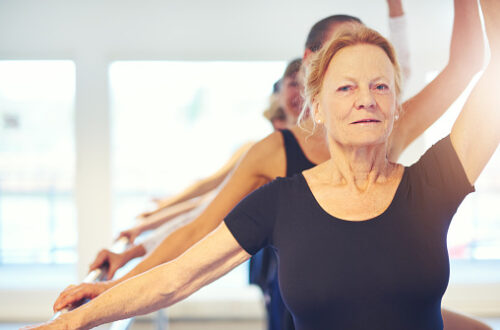
5 Key Principles of Functional Fitness: Improve Your Ability to Perform Everyday Tasks
“Nothing will work unless you do.”—Maya Angelou
It was a Saturday afternoon.
Marie had just started her weekly household chores.
Suddenly, Marie couldn’t get her breath and slumped down on the sofa.
Was Marie having a heart attack? How could that be? Marie was only fifty-seven years old but somewhat overweight.
“Statistics from the American Heart Association (AHA) state the average age of a person at the time of their first heart attack in the United States is 65.5 years for men and 72 years for female. However, heart attacks can happen to anyone.”
(Source: medicalnewstoday.com)
It would be sad enough if Marie’s situation were an isolated incident. But every day, heart attacks strike many persons in their thirties, forties, and fifties—killing or crippling them.
But why is this happening particularly in Western countries where there is material prosperity?
And why has it become an epidemic in this generation?
The consensus of medical experts is that there are many contributing factors, each of which adversely affects physical or functional fitness.
What Is Functional Fitness?
Functional fitness refers to the ability to perform daily activities efficiently and safely, with an emphasis on movements that mimic real-life activities.
Unlike physical fitness, which includes a broad range of components, functional fitness places a focus on movements that are directly applicable to daily life, work, or sports.
Functional fitness exercises often involve multi-joint movements and engage multiple muscle groups simultaneously.
Examples of activities include squats, lunges, pushing, pulling, and rotational movements.
The purpose of functional fitness is to improve the body’s ability to perform activities of daily living, enhance balance and coordination, and reduce the risks of injuries during functional tasks.
Rather than isolating specific muscle groups with traditional weightlifting exercises, functional fitness emphasizes movements that mimic real-life activities.
Is Functional Fitness Training for Older Women?
Yes, functional fitness training can be beneficial for older women.
Marie, mentioned above, was 57 years old at the time she thought she was having a heart attack.
Functional fitness focuses on exercises that mimic daily movements and activities, helping individuals improve their overall strength, flexibility, balance, and coordination.
For older women, this type of training can contribute to better mobility and independence in their daily lives.
Functional fitness exercises often involve movements like squats, lunges, pushing, pulling, and rotating, which can enhance functional capacity and reduce the risk of falls.
*However, before starting any exercise program, especially for older women, it is advisable to consult with a healthcare professional or a qualified fitness expert to ensure that the chosen exercises are safe and suitable for your health conditions and needs.
Five (5) Key Principles of Functional Fitness
Principles of functional fitness include:
- Multi-Joint Movements
- Core Stability
- Balance and Coordination
- Real-Life Application
- Variety of Movements
I will discuss these one by one.
No. 1: Multi-Joint Movements
Multiple joint movements refer to movements that involve more than one joint in the body.
The human body has various joints that allow for a wide range of movements.
When multiple joints work together, they enable complex and coordinated movements.
Here are some examples of multiple movements:
- Squatting: In a squat, the hip, knee, and ankle joints work together. The hip joint flexes, the knee joint flexes and extends, and the ankle joint dorsiflexes.
- Deadlift: During a deadlift, you use the hip and knee joints. The hips hinge and extend while the knees flex and extend.
- Shoulder Press: Raising your arms overhead involves movement at the shoulder and elbow joints. The shoulder joint abducts and flexes while the elbow joint extends.
- Push-Up: During a push-up, the shoulder, elbow, and wrist joints are engaged. The shoulder joint goes through flexion and extension, the elbow joint flexes and extends, and the wrist joint may experience some extension.
- Walking and Running: These activities involve multiple joints, including the hip, knee, and ankle joints. The hip flexes and extends, and the ankle dorsiflexes and plantarflexes.
- Jumping: Jumping involves the coordinated movement of the hip, knee, and ankle joints. The hip extends, the knee extends, and the ankle plantarflexes during the takeoff phase.
- Climbing stairs: Ascending or descending stairs engages multiple joints, including the hip, knee, and ankle joints. The hip flexes and extends, the knee flexes and extends, and the ankle dorsiflexes and plantarflexes.
No. 2: Core Stability
Core stability strength is a central component of functional fitness.
Many movements engage muscles of the core (abdominals, lower back, hips) to promote stability and balance.
Core stability refers to the ability of the muscles in the core region of the body to provide support and stability to the spine, pelvis, and shoulder girdle.
The core muscles include the abdomen, lower back, hips, and pelvis.
Core muscles work together to maintain proper posture, protect the spine, and facilitate efficient movement.
Strong core muscles contribute to better balance, coordination, and overall movement.
Strong core muscles improve the ability to:
- Swing a golf club
- Bend down and tie your shoes
- Reach and get a glass from a top self
Weak core muscles can lead to:
- Poor posture
- Lower back pain
- Muscle injuries
Strong core muscles may lower the risk of falls.
Examples of exercises that can help improve core stability:
- Sit-ups
- Planks
- Bridges
- Opposite arm and leg raise
- Rotational exercises
No. 3: Balance and Coordination
Functional fitness exercises often incorporate elements that challenge balance and coordination, promoting a more comprehensive approach to overall fitness.
Balance and coordination are two related but distinct aspects of physical ability.
Balance:
- Definition: Balance refers to the ability to maintain a stable and controlled body position, whether it is stationary or in motion.
- Components: It involves the coordination of sensory information from the eyes, inner ear, and proprioception (sensory input from muscles and joints).
- Examples: Standing on one leg, walking on a narrow beam, or maintaining stability during dynamic movements all require a sense of balance.
Coordination:
- Definition: Coordination involves the ability to use different parts of the body together smoothly and efficiently to perform a specific movement or task.
- Components: Coordination includes the integration of sensory input and the precise control of muscles to execute complex and well-timed movements.
- Examples: Activities such as playing a musical instrument, typing on a keyboard, or performing a dance routine all require good coordination.
Balance and coordination are crucial aspects of physical fitness, functional fitness, and overall well-being.
There are numerous benefits to having good balance and coordination:
- Prevention of falls.
- Enhanced athletic performance.
- Muscle strength and endurance.
- Joint stability.
- Improved posture.
- Neuromuscular control.
- Cognitive benefits.
- Functional independence.
- Injury prevention.
Specific strength training exercises can also help you improve balance and coordination.
The good news is that people of all ages and fitness levels can benefit from strength training.
Tai Chi is an excellent example, as this exercise uses a series of movements linked together in a continuous sequence, strengthening your coordination.
In summary, balance focuses on maintaining stability, while coordination involves the precise control and synchronization of movements.
Both balance and coordination are essential for performing various physical activities and contribute to overall motor skills and functional abilities.
No. 4: Real-Life Application
Functional fitness has various real-life applications beyond traditional gym workouts.
Here are some examples:
- Daily Activities: Functional fitness exercises mimic movements involved in activities such as bending, lifting, twisting, and reaching. By incorporating functional exercises into your routine, you can enhance your ability to perform these activities efficiently and without reduced risk of injury.
- Aging Gracefully: As you age, maintaining functional fitness becomes crucial for independence and overall well-being. Functional exercises can improve balance, flexibility, and strength, reducing the risk of falls and enhancing the ability to perform daily activities as individuals age.
- Weight Management: Functional fitness workouts often involve full-body movements that engage multiple muscle groups simultaneously, which can contribute to increased calorie expenditure and may be beneficial for weight management and overall health.
- Improved Posture: Many functional exercises focus on core strength and stability, which can lead to improved posture.
- Enhanced Cardiovascular Health: Functional workouts are designed to include cardiovascular elements, promoting heart health and endurance, which is achieved through activities like kettlebell swings, box jumps, or high-intensity interval training.
No. 5: Variety of Movements
Functional fitness programs encompass a wide range of movements, including pushing, pulling, squatting, lunging, rotating, and lifting.
This variety helps prevent boredom and ensures a well-rounded fitness level.
Here are some key reasons why incorporating a variety of movements is crucial in functional fitness:
- Holistic Fitness: Functional fitness aims to improve overall fitness by targeting multiple muscle groups and movement patterns. Including different movements ensures that the entire body is engaged, leading to a more balanced and holistic approach to fitness.
- Real-World Application: Functional fitness exercises mimic real-life movements, making it easier for individuals to apply fitness gains to everyday activities, which can enhance the ability to perform tasks easier and with ease and reduce risks of injury during routine tasks.
- Prevention of Imbalances: Focusing on a single type of movement or exercise can lead to muscle imbalances and overuse injuries. A variety of movements helps prevent these imbalances by promoting equal development of different muscle groups.
- Adaptability: Life involves a wide range of activities and movements. Incorporating various exercises prepares the body to adapt to different situations, improving overall functional capacity and resilience.
- Joint Health: Different movements engage various joints and promote joint flexibility and mobility, which is crucial for maintaining joint health, preventing stiffness, and reducing the risk of musculoskeletal issues.
- Enhanced Coordination and Stability: Functional fitness often involves multi-joint and multi-muscle movements, requiring better coordination and stability, which can improve overall motor skills and reduce the likelihood of falls or accidents.
- Increased Energy expenditure: Performing a variety of movements can lead to a higher calorie burn, which is beneficial for weight management and overall cardiovascular health.
- Long-term Motivation: A variety in workouts helps prevent boredom and keeps individuals motivated. Trying new movements and exercises can make your fitness routine more enjoyable and sustainable over the long term.
- Functional Independence. Functional fitness enhances functional independence, allowing individuals to maintain their ability to perform daily tasks as they age.
In summary, functional fitness is an exercise that supports and mimics your everyday life.
The variety of movements in functional fitness contributes to a well-rounded, adaptable, and functional body better equipped to handle the demands of daily life and various physical activities.
Weight training, on the other hand, is centered around lifting weights to build muscle mass and strength.
Both weight training and functional strength training have their benefits in that you can easily incorporate both into your fitness routine.
However, if you don’t have a lot of time to devote to fitness and general health goals, then functional fitness is just what you need.
Caution:
While functional fitness training is for older women 55+, deciding if functional fitness is right for you depends on various factors.
Here are a few things to think about:
- Overall fitness goals: Functional fitness is designed to improve our ability to perform daily activities and enhance overall functionality.
- Pre-existing conditions or injuries: Consider any health conditions or injuries you may have. Functional fitness often involves compound movements and full-body exercises.
- Variety and enjoyment: Functional fitness incorporates a variety of exercises, which can help keep workouts interesting.
- Real-world applications: If you value fitness that has practical applications in your daily life, functional fitness is designed to improve your performance in everyday activities.
- Fitness level: Functional fitness can be adapted to various fitness levels, but it’s essential to start at an appropriate intensity.
- Time commitment: Functional fitness workouts can often be efficient and time-effective, as they often involve compound exercises that work for multiple muscle groups simultaneously. If you have a busy schedule, this type of workout might be a good fit.
Before starting any exercise program, especially for older women, it is advisable to consult with a healthcare professional or a qualified fitness expert to ensure that the chosen exercises are safe and suitable for your health conditions and needs.
So, there you have it!
Why not begin your functional fitness journey today?
Right now!
Don’t wait!!
Key Takeaways
- Functional fitness refers to the ability to perform daily activities efficiently and safely, with an emphasis on movements that mimic real-life activities.
- Functional fitness training is safe for older women, but mature women should first check with their healthcare professional, especially if they have pre-existing conditions or injuries.
- The key principles of functional fitness include multi-joint movements, core stability, balance and coordination, real-life application, and a variety of movements.
- While both weight training and functional strength training have benefits, if you don’t have a lot of time to devote to fitness goals, then functional fitness is the way to go.
“Three little words: You’ve Got This!”—Unknown




